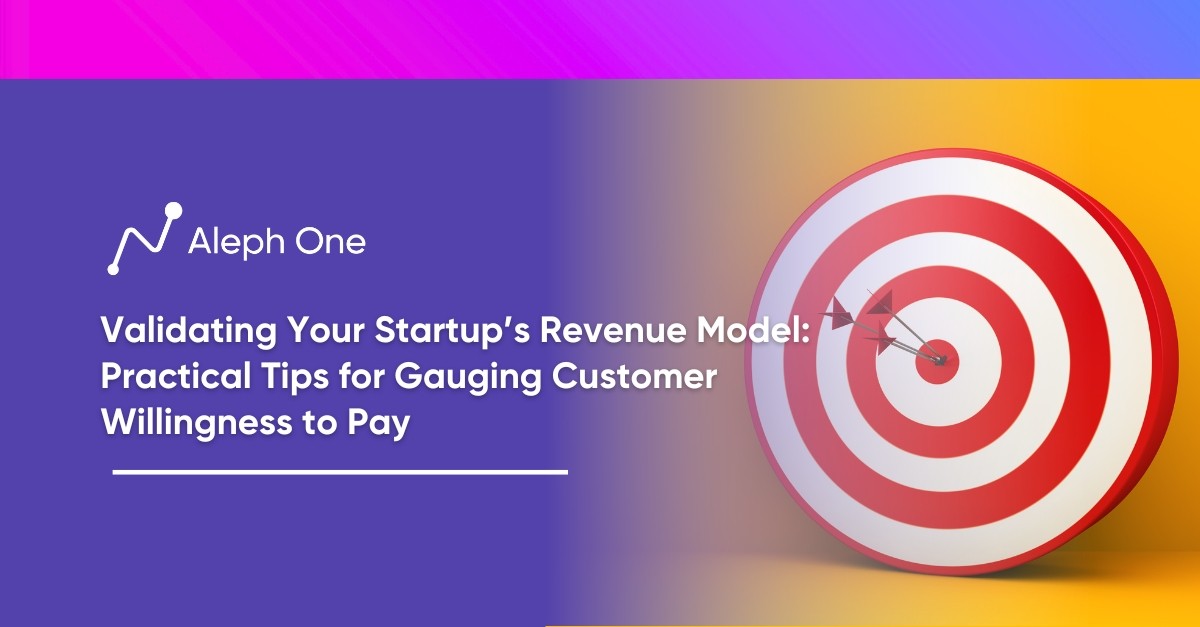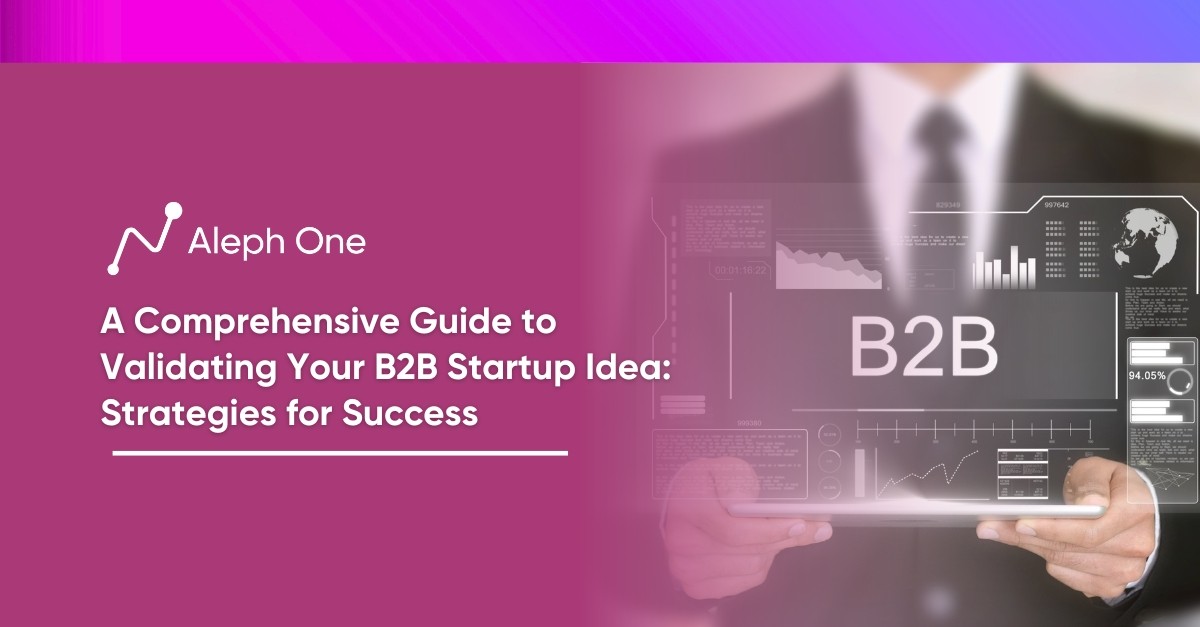Let’s work together to build something amazing. Share your project details and our team will reply to figure out the next steps to your success.

The success of your startup’s revenue model hinges on understanding your target customers and their willingness to pay. Rather than making assumptions, engaging directly with your customers to gain insights into their pain points and determine how much they would be willing to invest in a solution is crucial. This article provides practical tips for validating your revenue model, including conducting in-depth customer interviews, determining pricing potential, capitalizing on outliers, learning customer willingness to pay before launch, and continuously re-engaging with your target customers to ensure your pricing remains aligned with their evolving needs. The revenue model validation is an ongoing process that requires regular assessment, adjustment, and data-driven decision-making to maximize your startup’s chances of sustainable growth.

The Truth About Your Target Customers
As a startup, your revenue model is only as strong as your understanding of your target customers and their willingness to pay. Rather than making assumptions, head to the source – your target customers. Conduct in-depth interviews to understand their key pain points and how much they would be willing to pay for a solution.
Understanding Customer Pain Points
For example, if you are building an app to help busy parents organize their kids’ schedules, interview a diverse range of parents in your target demographic. Ask open-ended questions to learn more about the problems they currently face managing their children’s activities and how much time and money they spend on solutions, if any. Look for trends in their responses to determine a viable pricing range for your app.
Determining Pricing Potential
A good rule of thumb is interviewing at least 30-50 target customers to gain valuable insights into their needs and budget. Be sure to gather details on how much they currently pay for similar solutions or how much they would expect to pay for an app like yours. If responses cluster around a particular price range, that is a good indicator you can charge within that range.
Capitalizing on Outliers
However, also look for outliers in the data – customers who seem willing to pay a premium for an effective solution to their problems. These high-value customers will be your ideal customer base. Build a solution tailored to their needs and charge a price that matches the value.
Learning Customer Willingness to Pay Before Launch
The interviews may reveal that customers are less willing to pay than you had hoped. It is better to learn this upfront before you launch your product. You can adjust your solution to match what customers want and spend. Their input can help determine if a freemium model with upsells, or a lower-cost solution with a high volume of customers is the best.
Sustaining a Profitable Revenue Model
Continuously re-engage with your target customers to ensure your pricing and revenue models align with their needs as the market changes. While the initial interviews provide a snapshot, customer opinions, and budgets will evolve. Regular check-ins with your target base are crucial to optimizing your monetization strategy.
Put a Price on It – Test Different Options
One of the best ways to determine how much customers are willing to pay for your product is to test different price points. Create 3-4 pricing options for your MVP (minimum viable product) and see how customers respond to each tier. Their reaction will reveal the optimal price range that balances maximizing revenue with maintaining a high-enough demand.
Finding the Optimal Pricing Tier
When testing prices, start on the higher end of your estimated range. It is easier to bring costs down than to raise them after launch. Offer options to some early customers and see which tier gets the most traction. Try different features and capabilities at each price point to help customers understand the added value.
Balancing Revenue and Customer Base
Evaluate not just the number of customers who sign up for each plan but also look at the total revenue generated. The price point that brings in the most money is sometimes the optimal choice, especially if it significantly reduces your customer base. Find the balance of a price that covers your costs, maximizes revenue, and appeals to a broad enough audience.
Rolling Out Official Pricing
You can roll out your official pricing once you determine a viable price range from your testing. Continue monitoring customer response and revenue to see if further adjustments need to be made. Based on real-world data, startups often pivot their pricing at least once in the first year of business. Regular price testing and optimization should be an ongoing part of your strategy to ensure you have the best model to support and grow your startup.
Offer Discounts and Deals – But Not For Long
Running a limited-time promotion is a great way to gain valuable data on your customers’ price sensitivity while driving new sales. Offer a discount of 10-30% off your product or service for the first 100-500 customers. The scarcity created by the limited period taps into people’s fear of missing out and prompts them to act quickly to take advantage of the deal.
Avoiding Long-Term Discount Dependency
However, make the deal last only briefly, or you risk constantly training your customers to expect a discount. If you continually offer sales and promotions, customers will only purchase from you once the next deal is announced. This makes it very difficult to sell at a total price in the future.
Maximizing Impact Through Optimal Timing
Limit your initial discount promotion to 1-2 weeks for the best results. This gives customers adequate time to hear about the offer and make a purchase decision without dragging it on too long. You want the timeframe to be short enough that customers feel they need to act fast but long enough for word of mouth and social sharing to spread awareness of the deal.
Returning to Normal Pricing Post-Promotion
When the promotion ends, return to your standard pricing immediately. You may get some backlash from customers who missed out on the discount, but holding firm in your pricing is essential for establishing the true value of your product. If you continue to get complaints, you can reassure customers that you will offer additional short-term deals and promotions if they follow your company and sign up for email updates.
Interpreting Sales Response to Fine-Tune Pricing Structure
The data gathered from your limited-time discount can provide invaluable insights into how much of a deal motivates new customers to buy and what a reasonable base price might be for your product. If the response is strong, that is a signal that your average pricing may be too high. But if you receive only a modest sales bump during the promotion, that indicates your standard pricing is likely in the right ballpark. You can then make minor adjustments up or down based on the results.
With the customer data and feedback from short-term discount offers, you can validate that your revenue model and pricing align with what customers are genuinely willing to pay. But be careful to avoid continually offering deals or leaving money on the table training your customers to be deal-hunters.
Freemium is Your Friend – If Implemented Correctly
The freemium business model works by offering a free, basic version of your product to attract many customers, then encouraging a percentage of them to upgrade to a paid, premium version. When implemented correctly, freemium can effectively gain traction, build your customer base, and generate revenue. However, less than 5% of freemium customers become paying users.
Gating Compelling Features for Freemium Success
For freemium to work, you must provide enough value in the free version to capture customers’ interest but reserve some key features or capabilities for the premium version that a segment of your target market cannot do without. This could be access to more advanced tools, additional storage space, higher limits, or removal of ads. The features you gate behind a paywall should be relevant and compelling to your target high-value customers.
Simplifying the Path from Free to Paid Subscriptions
You also need a clear strategy to drive freemium customers to convert to your paid subscription. This includes highlighting your premium version’s key benefits and features prominently within your product and your marketing materials. Make it extremely easy for free users to view pricing details, sign up, and complete a purchase when it is right for them. Personalized in-app messages and notifications can also nudge active free users by highlighting the relevant benefits of upgrading.
Triggering Upgrades with The Paywall Point
Freemium works best when there is a logical point where your most engaged and committed free users will hit a “paywall” and need to upgrade to gain access to critical features they rely on. For example, once a free user has reached maximum storage in your app or built up an extensive library of content, they have a solid incentive to subscribe to continue using and building on what they have already created.
Strategic Implementation and Continuous Optimization
If implemented strategically, the freemium model can effectively establish a startup’s customer base and generate revenue. But you need to go in with realistic expectations about conversion rates and have a well-designed premium product and customer nurturing process to successfully motivate free users to paying for an upgrade. With regular optimization of your conversion strategy based on data, freemium can work for startups in many industries. But it is not a “set it and forget it” model and ongoing work is required to make it sustainable.
Don’t be Afraid to Pivot – When the Data Shows You’re Off
After conducting customer interviews, testing various pricing options, offering discounts and promotions, and trying a freemium model, it may be time to pivot if customers are unwilling to pay what you had hoped for your product. A pivot means changing one or more aspects of your business model better to meet customer needs and the realities of the market. This could include adjusting your pricing, product features, target customer, marketing and sales channels, or other vital factors.
Navigating Challenges to FInd a Sustainable Business Model
Pivoting is challenging but often necessary for startups to find a sustainable business model. It’s better to pivot when the data shows your current model is off rather than continue struggling on a path that will not lead to revenue and growth. Many of today’s most successful startups resulted from one or more strategic pivots.
Reassessing Target Customers and Pain Points
If customer data shows a lack of willingness to pay, return to the drawing board. Review your target customers, their pain points, and how well your product solves them. You may need to rework or replace some features. Or you may determine an entirely different customer segment or market may be a better fit.
Reshaping Your Approach
Pivoting also often requires changing how you market and sell your product. The channels and strategies you were using before may no longer apply. New positioning and messaging may be needed to resonate with your revised customer base or product.
Re-evaluating Your Model and Making Data-Driven Changes
Pivoting a startup is difficult but can be highly rewarding. While it’s not a decision to take lightly, feel free to pivot when your data clearly shows your current model is not viable and that a new direction could lead to greater success. Regularly re-evaluating your model and making data-driven changes is critical to optimizing your startup’s chance of finding a scalable revenue model.
Revenue Model Validation is an Ongoing Process
As a startup, your revenue model is the foundation of your business. But customer needs and preferences change over time, so you can’t validate your pricing strategy once and consider it done. Revenue model validation requires ongoing effort and commitment to regular testing and optimization.
4 Tips for Evaluating Your Revenue Model
1. Revisit Your Target Customers Regularly
To keep your revenue model up-to-date, revisit your target customers every 6-12 months to conduct new interviews and surveys. Look for any shifts in their pain points, needs, and willingness to pay. Their responses may prompt you to adjust pricing, develop new product tiers, or bundle additional features and services. It’s best to make incremental changes based on the latest customer data rather than dramatically overhauling your pricing.
2. Routinely Test Different Pricing Structures
You should also routinely test different pricing and discount options with customers to see how they respond. For example, try offering your premium plan at a lower price for a limited time to gauge interest, or bundle it with additional features at the regular price. Look at how many customers take advantage of the new offers versus your existing plans to determine the best path forward.
3. Be Transparent with Your Customers
When running pricing experiments, be very transparent with customers about what you’re testing and why. Let them know their feedback and participation will help make a better product for them in the long run. Most customers will appreciate your openness and willingness to improve the customer experience.
4. Pivot When Necessary
If, at any point, your pricing tests reveal that your current revenue model is no longer viable or sustainable, don’t be afraid to pivot. It is better to make a strategic change informed by data than to continue struggling with a model that needs to be fixed. Regularly revisiting your revenue model validation strategies will help ensure your startup stays on the right track.
Are you Ready to Create a Revenue Model for Your Startup?
Revenue model validation is not a one-time event. It requires diligent and ongoing work to analyze your latest customer data, test different options, and pivot as needed to optimize your pricing and monetization. With routine revalidation of your revenue model, your startup will be well-positioned to adapt to changes, build the best product for your customers, and maintain sustainable growth.
FAQ
How can startups use customer interviews to identify high-value customers and tailor their solution to their needs?
Startups can use customer interviews to identify high-value customers by asking open-ended questions about their pain points, how much they are currently spending on existing solutions, and what they would be willing to pay for an improved product. By analyzing trends and outliers in their responses, startups can identify customers who seem more willing to pay a premium for an effective solution, and then tailor their offering to address those customers’ specific needs.
What are some examples of successful pivots in pricing based on real-world data?
One example of a successful pivot in pricing based on real-world data is Dropbox. In 2014, Dropbox tested annual subscription plans ranging from $99 to $199 to find the best price for their cloud storage service. Based on the data they collected, the $99 plan received the most interest, so they rolled that out as their standard price, while still offering the $199 plan for power users.
How can startups strike a balance between providing a valuable free offering in a freemium model, while still offering compelling reasons to upgrade to the premium version?
To strike a balance in a freemium model, startups should provide enough value in the free version to capture customers’ interest, while reserving some key features for the premium version that will entice users to upgrade. These exclusive features should be relevant and compelling to the target high-value customers, making it worth their investment to upgrade. Additionally, startups can implement a clear strategy, like personalized in-app messages and notifications, to drive free users to view and consider upgrading to the paid version when the time is right for them.
Get the latest news and updates from Aleph One in your inbox.



